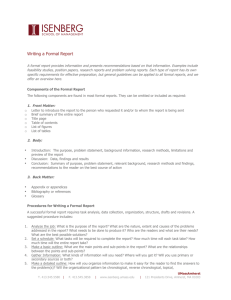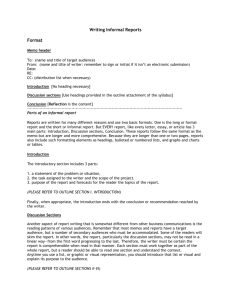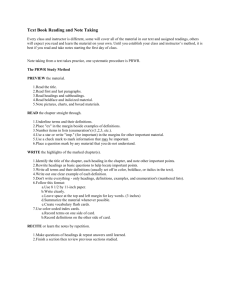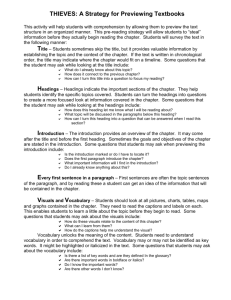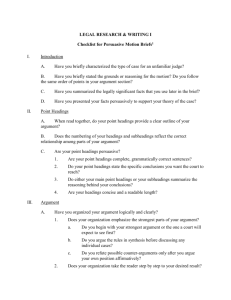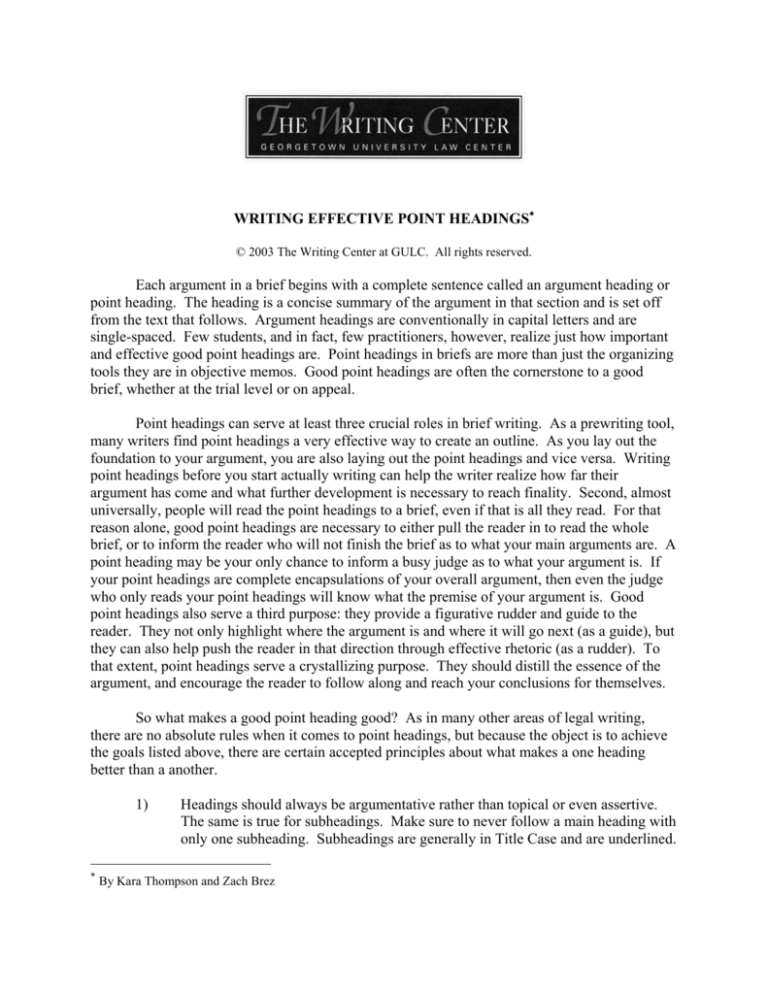
WRITING EFFECTIVE POINT HEADINGS∗
© 2003 The Writing Center at GULC. All rights reserved.
Each argument in a brief begins with a complete sentence called an argument heading or
point heading. The heading is a concise summary of the argument in that section and is set off
from the text that follows. Argument headings are conventionally in capital letters and are
single-spaced. Few students, and in fact, few practitioners, however, realize just how important
and effective good point headings are. Point headings in briefs are more than just the organizing
tools they are in objective memos. Good point headings are often the cornerstone to a good
brief, whether at the trial level or on appeal.
Point headings can serve at least three crucial roles in brief writing. As a prewriting tool,
many writers find point headings a very effective way to create an outline. As you lay out the
foundation to your argument, you are also laying out the point headings and vice versa. Writing
point headings before you start actually writing can help the writer realize how far their
argument has come and what further development is necessary to reach finality. Second, almost
universally, people will read the point headings to a brief, even if that is all they read. For that
reason alone, good point headings are necessary to either pull the reader in to read the whole
brief, or to inform the reader who will not finish the brief as to what your main arguments are. A
point heading may be your only chance to inform a busy judge as to what your argument is. If
your point headings are complete encapsulations of your overall argument, then even the judge
who only reads your point headings will know what the premise of your argument is. Good
point headings also serve a third purpose: they provide a figurative rudder and guide to the
reader. They not only highlight where the argument is and where it will go next (as a guide), but
they can also help push the reader in that direction through effective rhetoric (as a rudder). To
that extent, point headings serve a crystallizing purpose. They should distill the essence of the
argument, and encourage the reader to follow along and reach your conclusions for themselves.
So what makes a good point heading good? As in many other areas of legal writing,
there are no absolute rules when it comes to point headings, but because the object is to achieve
the goals listed above, there are certain accepted principles about what makes a one heading
better than a another.
1)
∗
Headings should always be argumentative rather than topical or even assertive.
The same is true for subheadings. Make sure to never follow a main heading with
only one subheading. Subheadings are generally in Title Case and are underlined.
By Kara Thompson and Zach Brez
2)
The point headings should be related to the questions presented, but should not
mirror them exactly. While the point headings should state, usually affirmatively,
the resolution of the issues raised in the Question Presented, the point headings
should not simply restate the question as an affirmative sentence. Why pass up
another opportunity to persuade through artful expression? Different rhetoric
styles will appeal to different readers, and point headings are another chance to
convince the reader who wasn’t convinced from the Question Presented. If the
Question Presented is more narrowly focused, make the point headings more
general, and vice versa.
3)
Effective argument headings will identify the applicable law; the way in which
the law applies to the facts of the case; and the conclusion that follows from that
application.
4)
While not every relevant fact can fit into a point heading, the writer should try to
imbed the heading into the memory of the reader through the use of powerful
wording and precise facts while avoiding adjectives and adverbs that may only
serve to exaggerate the argument.
5)
Point headings should always use tight, concise, well-though-out language that
works to engage the reader. You should continually re-craft your point headings
as your work through different drafts of your brief, working to hone your
language to be the most persuasive it can be.
On the following pages are some examples of good and not-so-good point headings.
Example 1.
Not so good: WHETHER THE SUIT IS BARRED BY LACHES.
[This is an ineffective point heading because it is a question that does not help the
reader in any way. Answering that question is the job of the writer, not the
reader, who usually looks for more guidance in a heading. This is just a sentence
fragment identifying an issue.]
Good:
THIS SUIT IS BARRED BY LACHES.
[This is better, but it is essentially just an answer to the question presented. The
reader has no sense of the “why” or “because”]
Better:
THIS SUIT IS BARRED BY LACHES BECAUSE IT WAS BROUGHT
TWENTY-FIVE YEARS AFTER THE ISSUANCE OF THE ORIGINAL
CERTIFICATE.
[This is much better. After reading the “because” part, the reader knows exactly
where the writer is going with his argument.]
Example 2.
Not so good: THE PLAINTIFFS SHOULD NOT GET DAMAGES.
[This is a pretty ineffective point heading. The sentence is just a direct response
to the Question Presented and therefore does not advance the writer’s rhetoric.]
Good:
THE COURT SHOULD NOT AWARD THE PLAINTIFFS DAMAGES FOR
THE COSTS OF RAISING THEIR NORMAL, HEALTHY DAUGHTER TO
MAJORITY.
[This is better, especially because the language is more precise and powerful.
Still, the writer has failed to give the reader the “why.”]
Better:
I.
THE COURT SHOULD NOT AWARD THE PLAINTIFFS DAMAGES
FOR THE COSTS OF RAISING THEIR NORMAL, HEALTHY DAUGHTER
TO MAJORITY.
A.
Suzanne’s Birth Did Not Injure The Plaintiffs Because They
Sought Sterilization For Non-Economic Reasons.
B.
Awarding Full Child-Rearing Costs Harms The Mental Health Of
Unwanted Children And Will Discourage Doctors From
Performing Needed Sterilizations.
[This is much better. It really helps to crystallize the argument by using
subheading and the writer is using powerful language to sway the reader with
both legal and public policy arguments, which are effectively separated into
subheadings.]
Example 3.
Not so good: THE TRIAL COURT’S DECISION IS REVERSIBLE.
[Yes, the decision is reversible, but what decision, and why is it reversible?]
Good:
THE TRIAL COURT’S DENIAL OF APPELLANT’S MOTION TO SUPPRESS
DIANA’S STATEMENT SHOULD BE REVERSED.
[Now we know what decision we are talking about, and the writer has
affirmatively stated her goals, but she has failed to give us the why.]
Better:
THE TRIAL COURT ERRED IN ADMITTING DIANA’S STATEMENT
BECAUSE HER STATEMENT WAS THE FRUIT OF AN ILLEGAL POLICE
SEIZURE AND THEREFORE MUST BE SUPPRESSED UNDER THE WONG
SUN DOCTRINE.
[Now we know what should have been suppressed and why. Also, the writer has
given the reader a guide as to the area of law that will be discussed in this
section.]
Example 4.
Not so good: IS THERE JURISDICTION FOR REVIEW OF A REFUSAL TO REOPEN A
MEDICARE PROVIDER’S COST REPORT UNDER THE FEDERAL
QUESTION STATUTE, 42 USC §1331.
[Once again, this is essentially a question that does not help the reader in any
way.]
Good:
FEDERAL COURTS DO NOT HAVE JURISDICTION UNDER 28 USC §1331
TO REVIEW REOPENING DENIALS.
[This is better, but just answers the question presented. The reader has no sense
of the “why.”]
Better:
I.
FEDERAL COURTS DO NOT HAVE JURISDICTION UNDER 28 USC
§1331 TO REVIEW REOPENING DENIALS BY INTERMEDIARIES
A.
42 USC §405(H) Prohibits Review Of Reopening Denials Under
28 USC 1331.
B.
Preclusion Of Judicial Review Under 28 USC 1331 Is Consistent
With Bowen V. Michigan Academy Of Family Physicians.
[This is much better. Even though the technical language is fairly dense, the
writer has done a good job of creating accessibility for the reader by separating
the arguments into subheadings that deal with separate issues. The writer has
applied the facts of the case to the underlying legal principles.]
Sources:
Alan D. Hornstein, Appellate Advocacy in a Nutshell (1998).
Robert J. Martineau, Appellate Practice and Procedure (1987).
Myron Moskovitz, Winning an Appeal (1985).
Introduction to Advocacy: Research, Writing and Argument (6th ed.1996).

